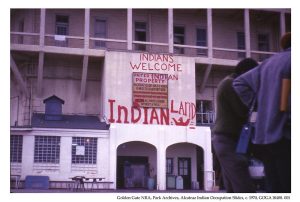41 The Red Power Movement in the United States by David Speer
1. Chronicling the leaders and activists involved

Native American activist Richard Oakes, Nov. 1969, National Parks Gallery via Picryl, Public Domain
| Curriculum Context | VCE Modern History Unit 2: The Changing World Order, Area of Study 2 (Challenge and Change) (VCAA, 2020) |
| Historical Context | Civil Rights Movement in the United States – The Red Power Movement – Significant Participants |
| Historical Thinking Concepts | Explore historical perspectives
Establish historical significance Using sources as evidence |
| Learning Intentions |
Describe how the Red Power Movement advocated for change.
Identify the significant individual leaders of the Movement and how they worked to affect change. Present information through a bibliographic writing style. |
Activity
Part A:
You will start by individually researching the Red Power Movement between (1961-1980) and detail the aims and objectives of this entire movement. Create a mind map detailing the different events and people involved. Include dates. Discuss the findings as a class.
Part B:
You will then research one organisation within the Red Power Movement (the American Indian Movement [AIM], Women of All Red Nations [WARN] for example) and find the main leaders involved in these movements (John Trudell, Dennis Banks, Russell Means [AIM], Madonna Thunderhawk, Lorelei Decora Means, Phyllis Young [WARN] to name a few). You could also choose another leader within the broader movement (Richard Oakes for example).
Choose one leader and write a 1-2 page biographical flyer about them, including details with these key prompts:
- Standard biographical details (place of birth, date of birth ect.) and all names associated with the individual.
- Write one paragraph on their early life before involvement in any Movements. Make note of any significant events in their early life, including but not limited to cultural assimilation, military service and/or politics.
- What significant events were they involved in within the Red Power Movement and in what way were they involved? How did they present their case, and to whom?
- Find three (3) contemporaneous quotes about the person, including one that was critical of the leader. Consider using newspaper sources and other primary sources for the quote. Attribute the quotes to the correct person or institution. Evaluate whether the person or institution was fair in their assessment
- A paragraph on this leaders’ life after the Red Power Movement.
- A summary paragraph that details the impact and legacy of your chosen leader on their specific movement, and on the Red Power Movement as a whole.
Include photos, colour and references.
References
VCAA. (2020). VCE Study Design: History 2022-2026. Victorian Curriculum and Assessment Authority. https://www.vcaa.vic.edu.au/curriculum/vce/vce-study-designs/history/Pages/index.aspx
2. The American Indian Movement: Analysing a significant Red Power Movement event

“Indian Land” Painted Entrance, c. 1970, GOGA Park Archives, via Flickr CC BY-ND 2.0
| Curriculum Context | VCE Modern History Unit 2: The Changing World Order, Area of Study 2 (Challenge and Change) (VCAA, 2020) |
| Historical Context | Civil Rights Movement in the United States – The Red Power Movement – Significant Participants |
| Historical Thinking Concepts | Explore historical perspectives
Establish historical significance Using sources as evidence |
| Learning Intentions |
Work in a group to establish detailed knowledge of a significant event.
Apply prior knowledge to new information to gain a greater sense of chronology and significance. Provide new information in an informative and engaging way. |
Activity
Part A:
Working in groups of 3-4 students, you will choose one significant event that the Red Power Movement engaged in, and create a 4-5 minute presentation detailing the event. Make sure there is only one event per group so the class can gain the widest knowledge.
Some events can include:
- The Occupation of Alcatraz Island (Richard Oakes delivering the Alcatraz Proclamation (1969) – YouTube)
- Trail of Broken Treaties (and the Twenty Point Position Paper) (National Park Services article)
- The Longest Walk (National Park Services article)
- Protest at Mount Rushmore (Mount Rushmore History TED Talk – YouTube)
- Wounded Knee Occupation (PBS Learning Media documentaries)
- Takeover of the Bureau of Indian Affairs (NY Times Article)
- Or select one event of your own choosing that you have found through research.
Use the sources provided as a starting point for your research. Your research should include several more sources, and a mixture of primary and secondary sources.
Here are some questions you can ask and explore within the presentation::
- What was the reason for this event? What was the significance of the event?
- How long did the event last?
- Who was involved in the event / what opposition was there to the event / what methods were employed by those involved to express their views?
- Was the event similar in any way to the Civil Rights and Black Power Movement events?
- Was the event successful in its outcomes?
- What effect did these events have on dominant power structures and do these events have any impact today?
Use at least one primary source for every question you address. The presentation can contain:
- Audio
- Interviews
- Video
- Music
- Contemporaneous news reporting
- Government reports
Part B:
After the presentation, you will follow up with a question-and-answer session with the whole class. Then, combine the presentations into one digital document, in chronological order, for each student to keep as a study guide.
References
American Experience (2022) The American Indian Movement and Wounded Knee | We Shall Remain: Wounded Knee
Blair, W.M. (1972) Indians in Capital Defy a Court Order, New York Times
Intelligent Channel (2013) Richard Oakes delivering the Alcatraz Proclamation (1969) -from THE EDUCATION ARCHIVE, YouTube.
National Park Service [NPS] (2023) The Longest Walk, 1978.
NPS (2023) The Trail of Broken Treaties, 1972.
TED-Ed (2021) The Dark History of Mount Rushmore – Ned Blackhawk and Jeffrey D. Means, YouTube.
VCAA. (2020). VCE Study Design: History 2022-2026. Victorian Curriculum and Assessment Authority. https://www.vcaa.vic.edu.au/curriculum/vce/vce-study-designs/history/Pages/index.aspx

